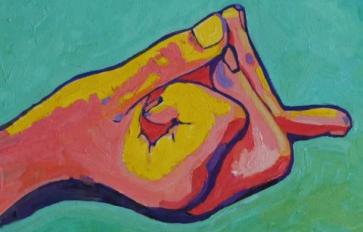
In India, temples are constructed with intention and obvious care utilizing the Science of Dwelling known as Vastu Shastra. The way the temples are built is meant to both reflect and inspire connection to the One Divine Source of creation as it also manifests within each person. By silently emitting a frequency and sacred geometry of balanced practical life merged with liberation, the Hindu temple is the perfect example of how to construct your life in alignment with universal balance.
Soft Boundaries
Built with an “open” floor plan, the finished structure is not designed to keep people out, but rather to invite community and union through a soft-boundary of the sacred infused throughout. In the west, we take boundary setting very seriously, but in India, the lines are less drawn and rather open to allow for no separation between the secular and the spiritual life. The temple boundaries are not clearly drawn so as to encourage the worshipper and visitor alike to take care of dividing spiritual and secular life – for they, in fact, co-mingle naturally.
Four Main Elements
As one walks into the sanctum, there are four main walls which represent the spiritual realms as well as the four main areas a person must focus energy toward in order to find harmony in life. They are:
1- The Pursuit of Artha (prosperity/wealth)
2- The Pursuit of Kama (pleasure/sex)
3- The Pursuit of Dharma (virtues/life path/mission)
4- The Pursuit of Moksha (liberation)
All four of these areas must be balanced in order to have the temple (Self) solid and standing, able to hold the presence of the Divine. In other words, if any of these areas are lacking or weaker than the others, the temple structure lacks strength and stability. The structure cannot stand with only 2 or 3 walls; it needs all four areas taken into account and honored.
Womb Space
In the center of the four walls there is an empty space -- representing the formless universal spirit, the life-essence which infuses all -- called the Garbha Griha – literally translating as “womb space” or “womb house.” Just as in the womb of the woman, the zero point of creation is the place within that allows for the unknown to enter. It is in this space from which all creation springs. Whether it is an actual child or another creation, that space within each person which imagines and births something new – this is what is represented in the Hindu temple and is reminded in each one who visits – whether consciously or not. By bringing the empty “womb space” into central focus in our lives and honoring the truth, that from the formlessness does come form, we can begin to bring back the power of both the feminine womb space as well as the creative mystical spark inherit in each person.
In order for the Divine to “enter in” we must make space for it. In order for Infinite presence to fill our being and bounce off of and be “contained” by the four walls of our life's greatness (our abundance, pleasure, personal mission and surrender), we must acknowledge that space within us from where this greatness springs. All of these things together create an alchemical formula for the manifestation of the pristine life, the one in which Divine presence makes itself known and inspires all aspects of the person.
The structure of the Hindu temple alone is built to inspire a remembrance of the simple path to God, the straightforward directive that speaks right to the soul. When we can observe this, we can perhaps approach the construction of our lives mentally and then surrender into what has, for thousands of years, been whispered in the darkness of the pilgrim's walk.
The Crown
Above the central point of the mandala of the temple grounds rises a dome-like structure known as the Shikhara (in the north of India) or Vimana (in the south), representing the Cosmic mountains or birthplace of reality. This is also meant to symbolize where the gods/goddesses live and find residence. In one's body, this space would be akin to the head, and the center of consciousness wherein remembrance of the greater reality lives on a regular basis. I imagine this to be as an awakened crown chakra, always attuned to the vastness of the universe, sitting gracefully above the still, empty vacuum of creative potentiality at the center and around which we build our life. These two points – the Crown and the Womb space – work together in the manifestation process of anything we wish to dance with in this life.
The Form of the Divine Within
Beneath the dome and next to the womb house usually sits an idol of some sort, the representing and “presiding” deity of the temple. In one's own person, this imagery could be embodied as the enlightened, authentic personality who resides in your form, the way in which you choose to “live into” your own personal contact with the Divine within.
The Akashic Records
The walkway that circles the center point of womb house and deity in the Hindu temple usually depicts various stories from the holy scriptures or images of the deity. I think of this, in a person, as akin to one's own storybook of life events, the Akashic records that encircles each one of us etherically, which emanates energetically into our fields and dictates how the world interprets us and how we interact with the world. By keeping our personal “story field” clear and updated, releasing any trapped stories, emotional wounds and inherited patterns, we are keeping our temple ambulatory clean and clear and full of the “best stories” with which to influence and impress upon the world.
What do you want your energy field to say to others?
By consciously choosing to do work on your personal field of subconscious stories and buried patterns you are keeping your personal temple clean and inviting those with high frequency to visit you there and take part in your personal creation story.
There are so many more aspects to a Hindu temple, which by studying and embodying we can find greater alignment and heightened receptivity to the energies and insights available to us all. By constructing your life like a Hindu temple you can begin to find the harmonious balance and resonate frequencies the temple builders were keen to in times of old.
Photo Credit: Shore Temple, Mahabalipuram by Vikas Rama is licensed under CC BY 2.0








